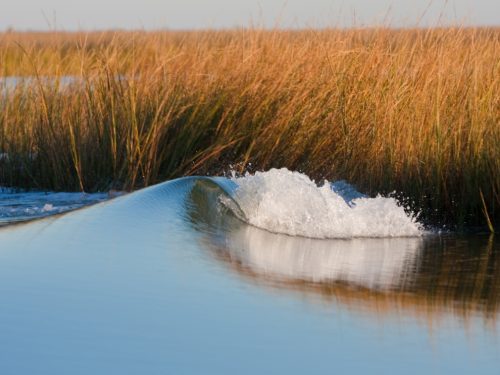Blue Carbon: Uncovering the Hidden Forces Below the Sea Surface

Photo Credit : ICCTF
The ocean holds the secrets of incredible natural wonders. As well as being home to amazing biodiversity, oceans also have a strategic role in storing carbon through ecosystems known as Blue Carbon. Blue Carbon refers to carbon stocks stored in coastal ecosystems, such as mangroves, seagrass beds, and tidal mars.
- What is Blue Carbon?
Blue Carbon is a term that refers to carbon accumulated in coastal ecosystems. These ecosystems, such as mangroves, seagrass beds, and tidal marsh, have a remarkable ability to absorb and store carbon from the atmosphere. This process occurs through photosynthesis by plants and marine organisms within these ecosystems, which then bury carbon in soil or underwater sediments. This uniqueness allows carbon to remain locked in coastal ecosystems for centuries, making it an effective buffer in reducing the concentration of carbon dioxide (CO2) in the atmosphere.
Mangroves are a type of forest that grows in coastal areas and has an important role in the Blue Carbon ecosystem. Mangrove forests in Indonesia cover more than 24% of the world's total mangrove area, covering an area of 3.36 million hectares. Mangroves have high productivity and large underground carbon stocks, making them the most carbon-rich blue carbon ecosystem (BCE).

Photo Credit : Damsea/Shutterstock
Seagrass Beds are coastal ecosystems that have the ability to bind organic material and carbon which will be stored in underwater soil. Seagrass beds and mangroves are the most effective blue carbon sinks. Their ability to sequester CO2 from the atmosphere far exceeds that of terrestrial ecosystems.

Photo Credit : Ethan Daniels/Shutterstock
Tidal Marshes are swamps found along rivers, coasts, and estuaries that experience flooding and drying by tidal movement from adjacent estuaries, seas, or oceans. Tidal marsh form in areas protected from waves (such as on the shores of bays), on intertidal upper slopes, and where the water is fresh or salty. Tidal swamps play a similar ecological role to mangroves and are very important 'blue carbon' ecosystems found in cold, temperate climates and some tropical regions. These swamps store carbon in their soils for thousands of years, making them important contributors to climate change mitigation efforts.

Photo Credit : Patty Bodwell
- The Importance of Blue Carbon in Climate Change
The role of Blue Carbon is crucial in efforts to mitigate climate change. Coastal ecosystems are able to absorb and store carbon more effectively than forests on land. Although coastal ecosystems cover only about 2% of the total ocean area, they can store up to 50 times more carbon per hectare than tropical rainforests. By preserving and restoring coastal ecosystems, we can contribute to the reduction of atmospheric CO2 concentrations, which is one of the main drivers of climate change.
- Threats to Blue Carbon
Unfortunately, coastal ecosystems and Blue Carbon are currently faced with serious threats. Climate change, urbanization, mangrove deforestation, and other human activities have caused damage and degradation of coastal ecosystems. When these ecosystems are damaged, the carbon trapped in them can be released back into the atmosphere as greenhouse gases, accelerating the pace of climate change. Therefore, the protection and restoration of coastal ecosystems is very important to maintain the sustainability of Blue Carbon.
- Other Benefits of Blue Carbon
Apart from being carbon buffers, coastal ecosystems also provide significant ecological benefits. Mangroves, for example, serve as shelter and breeding grounds for various species of fish and other animals, while seagrass beds provide nests and food sources for a variety of marine species. By safeguarding coastal ecosystems, we not only protect Blue Carbon but also ensure the sustainability of natural resources and the well-being of coastal communities.
Conclusion
Blue Carbon is a hidden wealth that needs to be revealed below the surface of the ocean. Through coastal ecosystems, such as mangroves, seagrass beds, and tidal marsh, carbon can be effectively stored to help reduce atmospheric CO2 concentrations. However, threats to coastal ecosystems require deep protection and recovery measures to maintain the sustainability of Blue Carbon and minimize its negative impact on climate change. By engaging collective efforts, we can ensure that Blue Carbon remains a valuable asset for life on land and sea.
References
ppid.menlhk.go.id
www.mongabay.co.id
repository.ugm.ac.id

